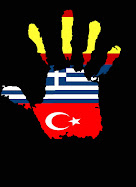Sarý Zeybek
Gullü nos ha contado que los zeybeks son un tipo de baile turco lento y sugerente que también practican los griegos. Representan la determinación, la valentía y la fuerza de los caballeros turcos. Los griegos chipriotas los llaman “zeybekikos” y los griegos de Rodas los llaman “turkikos”. Son populares en el centro y oeste de Anatolia. Los zeybeks que tienen letra no se bailan en la parte que se canta, sólo en la instrumental. Los procedentes de Chipre tienen un ritmo más rápido. Nos incluye una lista de los principales juegos zeybek que podéis consultar en la versión en inglés.
Los zeybeks eran guerreros de las montañas de la parte oeste de Anatolia entre los siglos XIII y XIX. Actuaban como protectores de los aldeanos frente a los lugartenientes, bandoleros y recaudadores de impuestos. Uno de los líderes de una banda zeybek se llamaba Efe y a sus soldados se les conocía como kyzan, palabra que generalmente designaba a los zeybek no entrenados. Eran como una tribu con una estructura grupal democrática y seguían rituales fijos para todo lo que hacían.
Aquellos zeybek ya tenían danzas especiales, de hecho algunas piezas de corte romántico sobre su valentía todavía son populares dentro del folklore turco. Usaban la espada “yatagan” como arma principal pero también utilizaban armas de fuego.
Zeybeks are relatively slow and have more swaggering attitude than other dances. They represent the determination, braveness and strength of the males. Zeybeks' origin is known to be Turkish. They have also been used by Greeks. Greek Cypriots call it "Zeybekikos" and Rhodos Greeks call it "Turkikos". They are very popular in Western and Central Anatolia. In zeybeks which have lyrics, the parts with lyrics are not danced. Cyprus Zeybeks are relatively faster. Abdal Zeybegi, Sarhos Zeybegi, Kibris Zeybegi, Iskele Zeybegi are the most popular zeybeks...
Main Zeybek Games
1- Zeybek 1
2- Abdal Zeybeği
3- Sarhos Zeybegi
4- Sarı Zeybek
5- Kıbrıs Zeybegi
6- Anadolu Zeybegi
7- Iskele Zeybegi
8- Abahor Zeybegi
Zeybeks or sometimes Zeibeks were people living in Asia Minor. The majority of them came from Yörük and Turkmen villages.[citation needed]
Before the establishment of the Republic of Turkey, large concentrations of Zeibeks could be found in western Anatolia, particularly in Isparta, Burdur, Afyon, Kütahya, Uşak, Denizli, Aydın, İzmir, Manisa, Mugla, Antalya, and the Balıkesir area.
Zeybeks were mountain warriors of Western Anatolia during the 13th - 19th centuries. Zeybeks generally had Turkmen and Yörük origins. They acted as protectors of village people against landlords, bandits and tax collectors. A leader of a Zeybek gang was called "efe" and his soldiers were known as "kızan"."Kızan" was generally used for untrained Zeybeks. There was generally a tribe democracy in group. Decisions was taken in a democratic way, after the decision was taken "Efe" has an uncontroversial authority. They followed definite rituals for all actions; for example, the promotion of a "kızan" to zeybek was very similar to Ahi rituals.
Zeybeks had a special dance in which performers simulated hawks. Romantic songs about their bravery are still popular in Turkish folk music. The yatagan sword was their primary weapon, but most of them carried firearms as well.
BIENVENIDA / WELCOME
Este blog es el instrumento de comunicación para todos los participantes en el Programa de Aprendizaje Permanente (P.A.P.) Comenius. Se trata de una asociación multilateral entre tres países: Turquía, Grecia y España. Nuestros centros educativos van a trabajar temas relacionados con la historia, las tradiciones, la religión, el ciclo festivo, etc. Y nuestro principal objetivo es estrechar los lazos que unen a estas tres culturas mediterráneas.
This blog is a communication tool for every participant in the Comenius Lifelong Learning Programme (L.L.P.). It is a multilateral association of schools in these three countries: Turkey, Greece and Spain. We are going to deal with subjects such as History, Traditions, Religion, The Festive Cycle, etc. And our main objective is to approach the similarities which these three Mediterranean cultures have.
This blog is a communication tool for every participant in the Comenius Lifelong Learning Programme (L.L.P.). It is a multilateral association of schools in these three countries: Turkey, Greece and Spain. We are going to deal with subjects such as History, Traditions, Religion, The Festive Cycle, etc. And our main objective is to approach the similarities which these three Mediterranean cultures have.
martes, 6 de mayo de 2008
Más canciones turcas / More Turkish lyrics
Etiquetas:
FOLKLORE / FOLKLORE,
MÚSICA / MUSIC
Suscribirse a:
Enviar comentarios (Atom)










0 comentarios:
Publicar un comentario